Once upon a time, in a land far, far away, I worked in an art museum. One of my favorite things about going to work was the time before the museum opened, when it was just staff (who were mostly in their offices) and the museum guards. Being the only person in a gallery full of artwork is awesome, at least in my opinion. There is no maneuvering around people blocking the view, or waiting for someone to move so you can read the label, or weird looks from people who are watching you look at a painting from a distance, then up close, and then from a distance again. (What, that’s not how you look at paintings?) Being the lone visitor in a gallery makes me feel like the work is there just for me, and that I have time and space to sit with it. It’s sort of magical and quiet, and one of my favorite things in the world.
This is exactly how I felt last week when I visited Krannert Art Museum. KAM reopened earlier this fall, with timed tickets available on its website. Tickets are free, and the reservation process was incredibly easy; you simply select the date and time you’d like to visit. I had been apprehensive about visiting the University of Illinois campus during a pandemic, but kept an eye on the COVID case numbers on campus before booking my visit. There are fewer cases than in September, and —let’s be honest here — there were no students visiting the museum when I did. On my visit I only encountered masked museum guards.
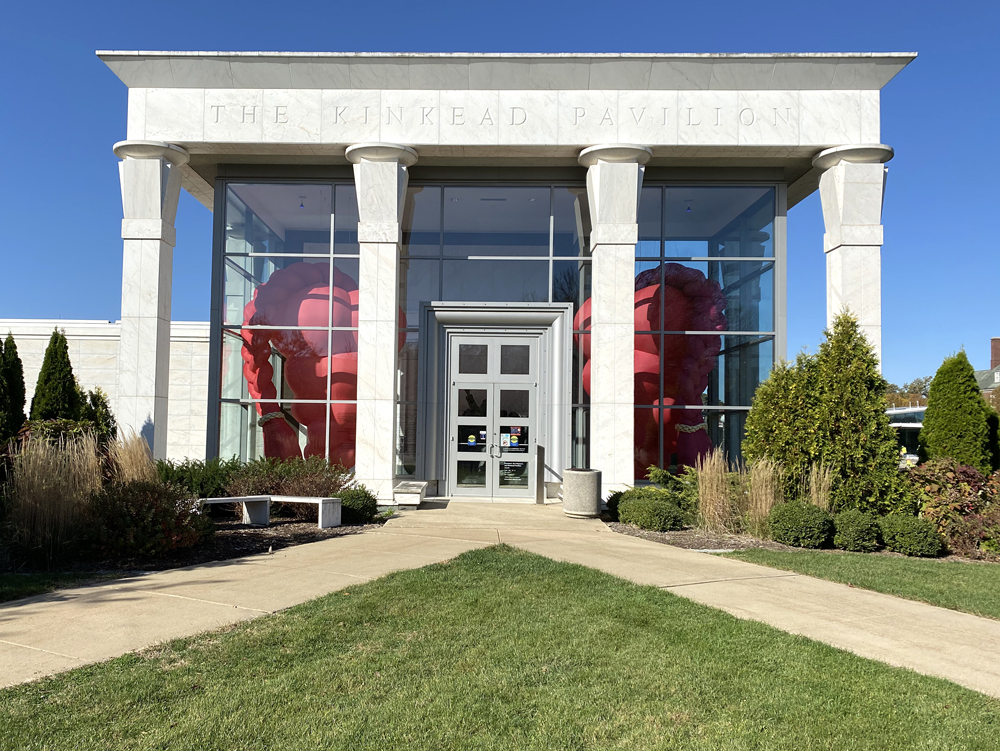
Photo by Jessica Hammie.
Nancy Davidson’s Hive sculptures were very visible from the street; it’s hard to imagine that they were installed in January, and that January was this year. Visiting Hive again gave me a new opportunity to hear Lakshmi Ramgopal’s sound component to the installation, a series of moans, groans, and exhalations. The sculptures already feel like living, breathing entities, and the corresponding sound creates a totally immersive experience. It’s very much worth spending some time with this work in the Kinkead Pavilion. I imagine it will be particularly mesmerizing in the darkness, which is creeping earlier and earlier each passing day.
After entering the museum proper I was greed by a guard who inquired as to whether or I had a ticket; I did, and he confirmed my name on his list. After that, I was left to explore the museum without interruption.
I lazily made my way through the Bow and Trees Galleries. I usually visit KAM for the opening receptions for new exhibitions, so spending time with these parts of the permanent collection was really nice. I was able to stumble upon new acquisitions and things I didn’t know the museum had in its collection. As the only other visitor, I expected near silence, but the creaky wood floors announced every single one of my movements. It was sort of funny, but there wasn’t anyone there to laugh with me save for Diane of France, Daughter of King Henri II.
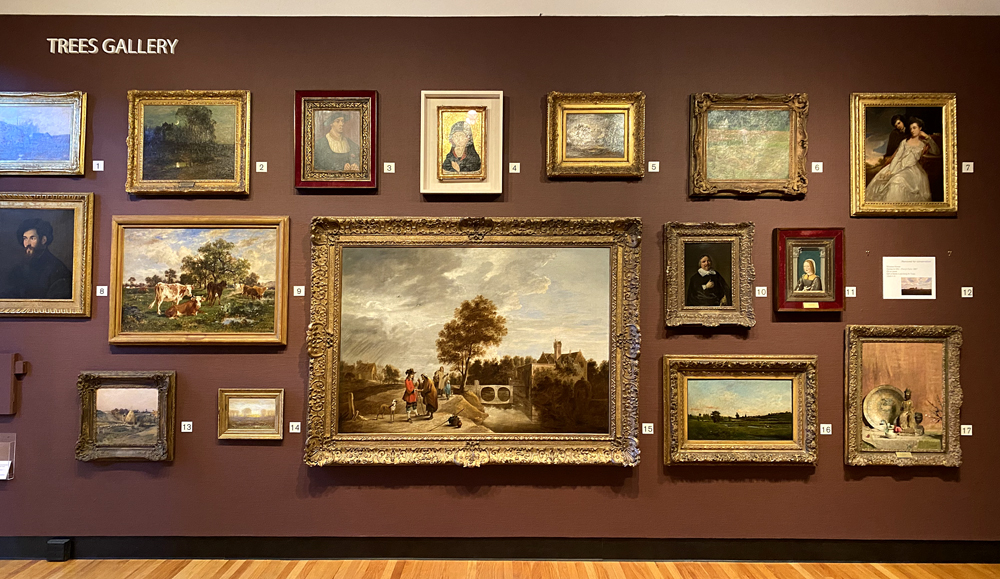
Photo by Jessica Hammie.
One of my favorite aspects of the Trees Gallery is the salon wall. I appreciate the ways in which, when done well, these salon walls can use the tools of the past to challenge the ways we understand images today. When you visit KAM, take a few moments to sit and enjoy the Trees Gallery.
As I moved on from some of the older works, I stopped in to check out “Homemade, with Love: More Living Room,” a multimedia installation that centers the experiences of Black girls. The meticulous installation offered plenty of opportunities to discover small details, like TLC’s CrazySexyCool cassette tape and Brandy’s single Baby on vinyl. The exhibition is curated and created by SOLHOT and St. Louis-based artist Jen Everett.
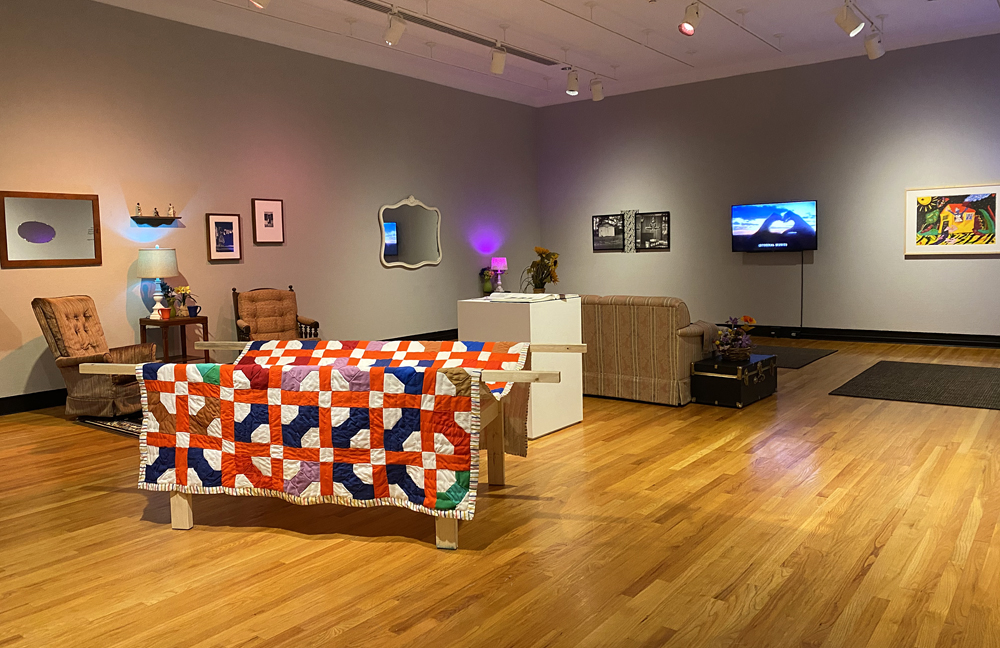
Photo by Jessica Hammie.
I bypassed “Art Since 1948,” since I had already visited the exhibition several times in the pre-pandemic world. It’s a show worth seeing, so if you haven’t spent time with it, read our review and then see it for yourself.
I was most interested in viewing the newest exhibition, “Pressing Issues: Printmaking as Social Justice in 1930s United States.” The exhibition opened to the public October 3rd and will remain on view through December 23rd. The show takes up two gallery spaces in the western part of the museum, wedged between “Art Since 1948” and the “Encounters: The Arts of Africa” gallery.
“Pressing Issues” is organized into four categories: Women at Work; Condemning Racial Terror; Denouncing Fascism; and Fighting for Workers’ Rights. The exhibition offers perspectives on the ways in which artists engaged with the aforementioned social justice issues in the decade that experienced the Great Depression and the eve of World War II. But it also serves as a mirror to our own times, reflecting the world we currently occupy. On one hand, it’s flippant and cynical to say that nothing has changed, but on the other, we are more technologically advanced, and many things have improved for women, Black people, and immigrants.
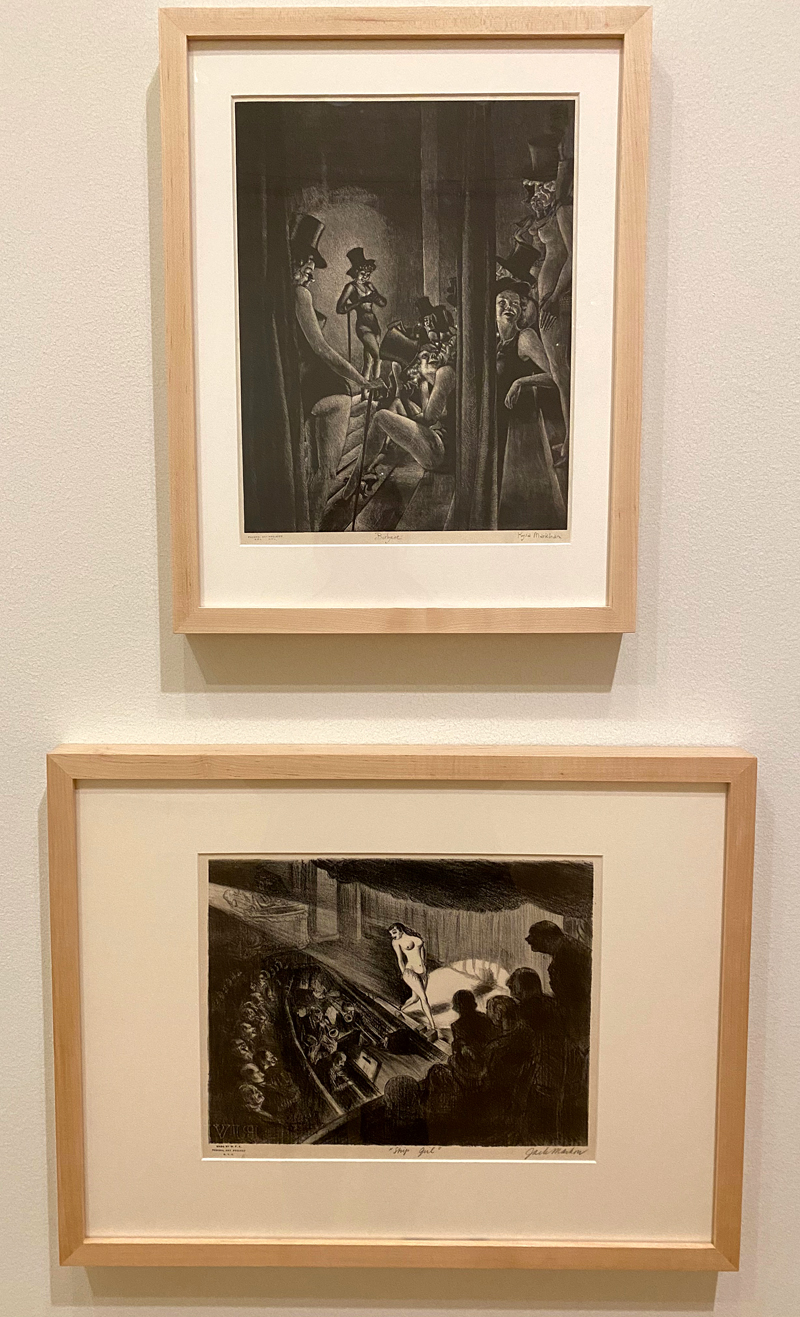
Kyra Markham’s Burlycue, ca. 1934-43 (top), and Jack Markow’s Strip Girl, ca. 1934-43 (bottom). Photo by Jessica Hammie.
Take, for instance, the smart juxtaposition of Kyra Markham’s Burlycue (ca. 1934-43) and Jack Markow’s Strip Girl (ca. 1934-43). Both prints were made around the same time, and both feature women performing burlesque. Markham’s lithograph features about ten dancers backstage, in conversation with each other, laughing, waiting, taking a break. There is nudity in the image, but the nudity isn’t the point of the image. Compositionally, women’s breasts are pictured on the edge of the paper, and almost function as a framing device for the faces of the women. Conversely, Strip Girl pictures a burlesque dancer on a stage. Our perspective as a viewer puts us in the balcony on the side of the stage, so we are literally looking down on the topless woman. It is a scene of a performance, and the audience is in shadow while the woman is bathed in a spotlight. Her nudity, her existence, is for our pleasure.
Placing these two prints together, stacked, makes this comparison very clear for museum visitors. I hope viewers question their own ideas about labor and whose bodies matter, and how the narrative shifts depending on who is telling the story. These are conversations we continue to navigate today, through everything from the consideration of women’s representation in art and media and conversations about sex work on OnlyFans to FOSTA-SESTA.
The section called “Condemning Racial Terror” featured two artworks, both by white, male artists. According to the wall label, Manhunt (1934) by John Steuart Curry, features a white mob on the hunt for a Black person to lynch. The image features armed men on horseback and foot with dogs, and is clearly meant invoke the terror of mob violence and extrajudicial murder. It also recalls imagery of slave patrols searching for escaped enslaved people. The other print, Ku Kluxers (1939) by Chet La More, is one of only a handful of images with color in this exhibition. The striking lithograph features three hooded Ku Klux Klan members in profile, their white robes stained with red.
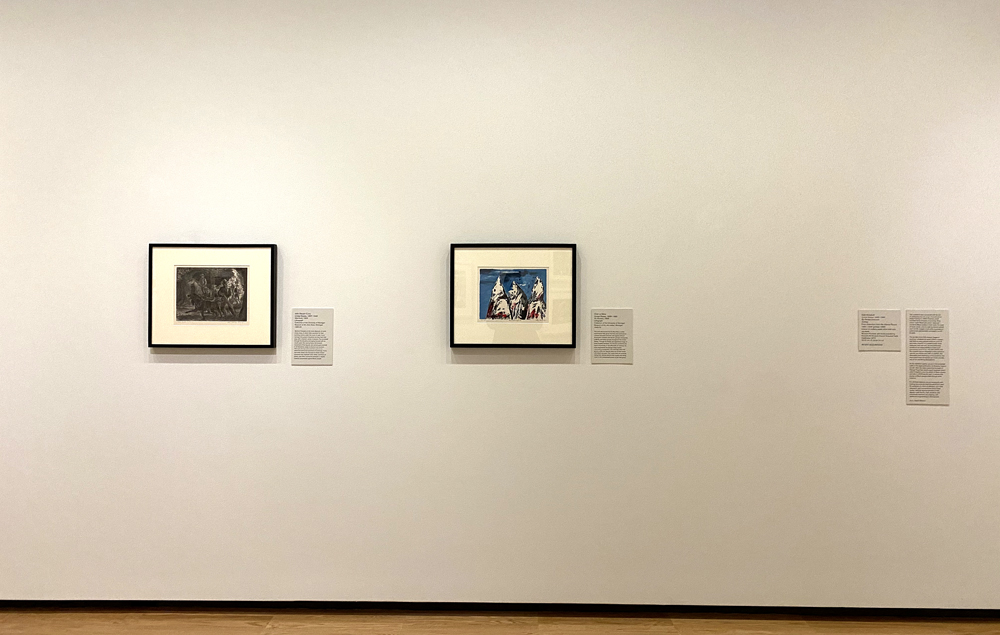
Photo by Jessica Hammie.
To the right of these prints is an empty space on the wall, followed by a wall label for two linocuts by Hale Woodruff: By Parties Unknown and Giddap. There is an additional label with a four-paragraph explanation from KAM Director Jon L. Seydl outlining why the museum has removed (or never installed) the work. To summarize, the work depicts lynched Black men, and Seydl notes that viewing images of deceased Black people can be a type of secondary trauma — as recently evidenced by the mass circulation of the videos of the murders of George Floyd, Philando Castile, and others. This is undoubtedly true, but I question the success of completely censoring the work.
To be clear: I fully believe and understand the potential for images of murdered Black people to be deeply triggering and traumatic. It is ultimately not for me to say what is or is not appropriate to exhibit in this museum, as I am neither an employee nor a Black person who is being asked to endure this imagery. However, in an exhibition with few examples of art made by Black artists, to essentially silence a Black man who felt compelled to make these images as a response to his lived experience seems to undermine the efforts to “Condemn Racial Terror.” It removes the protagonism of the Black artist who endured the threat of this type of violence, and instead cedes this position to two white artists who pictured more white people, thereby making the entire small section about whiteness. Seydl’s statement notes that there is “additional programming in development,” but none about this has been announced at the time of publishing.
The luxury of having an art museum almost entirely to yourself is the stuff of books and movies (and the lives of the Knowles-Carter family). Despite what you might imagine, it’s hardly a silent experience. As I noted, the floors creak, you notice the movement of the guards, the hum of the various humidity gauges creates this strange quiet cacophony that reminds me of tinnitus, but in a sort of nice, comforting way. KAM has so much on view, and even if you think you’ve seen it all, you most certainly haven’t. It’s an amazing resource that I think we may take for granted.
Visiting KAM during this pandemic may not be at the top of your list of activities, but I encourage you to amend your list. Following state guidelines, each gallery has a much smaller maximum capacity, and frankly, droves of people are not visiting the museum on a weekday morning. It’s a relatively low-risk and wonderful way to engage with arts, culture, and the outside world. There are plenty of things to discover, both in new exhibitions and in the permanent collection.
Krannert Art Museum
500 E Peabody Dr
Champaign
T-Sa 10 a.m. to 4 p.m.








